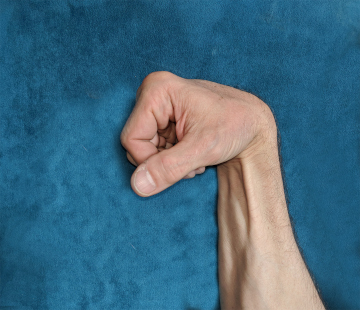Multiarticulate Muscles
- Whitney Lowe
Muscles have a primary role in creating and limiting movement in the body. They are also the major focus of our work in massage therapy, with many injuries caused by improper loads on the muscular system. There are key facets of analyzing a muscle’s mechanical load that are essential in both assessment and treatment strategies. One factor that is important for recognizing excess loads is how many joints the muscle crosses. The more joints a muscle crosses, the more complex its load management becomes. Many muscles, such as the supraspinatus, span a single joint and are only responsible for creating movement across that joint. Other muscles – such as the hamstrings, biceps brachii, or finger flexors – cross more than one joint. A muscle that crosses more than one joint is called biarticulate or multiarticulate. A biarticulate muscle, like the semitendinosis, crosses two joints. A multiarticulate muscle, such as the flexor digitorum profundus in the hand, crosses two or more joints (Figure 1).

Figure 1
Flexor digitorum profundus crossing multiple joints
Image is from 3D4Medical’s Complete Anatomy application
During a concentric contraction, a muscle shortens and its two ends move toward each other. However, movement is not that simple. We accomplish most movements because the limb or body region that one end of a muscle attaches to is held stationary. The limb at the other end of the attachment moves toward the stationary limb as the muscle contracts.
Multiarticulate muscles’ actions are even more complicated because these muscles’ actions occur across two or more joints. Some multiarticulate muscles have similar actions across all the joints that they span. For example, the flexor digitorum profundus creates flexion at the wrist as well as flexion of each finger joint it crosses. The hamstrings, on the other hand, create extension at one joint (the hip) and flexion at another (the knee). Muscular problems involving multi-articulate muscles must take into consideration how these muscles are contracting or stretching over all involved joints.
One of the unique capabilities of multiarticulate muscles is that they can generate force without changing their length while motion is occurring at a joint. Definitions of an isometric muscle contraction state that it is one in which the muscle generates force, but there is no change in the muscle’s length and no motion occurring at the joint(s) the muscle crosses. Interestingly, multiarticulate muscles are capable of isometric contraction (no change in muscle length) while motion is occurring at the joints they cross. Let’s look at how that could occur.
Consider the hamstrings, a multiarticulate muscle which both extend the hip and flex the knee. Suppose that during a squat the hamstrings are engaged to contract and the amount of hip flexion (which we would think of as lengthening the muscle) exactly matched the amount of knee flexion (which we would think of as shortening the muscle). These two joint actions could cancel each other out in terms of how the movement affected the overall length of the muscle. Then there would be no change in muscle length even though there was a contraction engaged and motion occurring at the joint. That example is a bit of a thought puzzle, but it does help us understand how multiarticulate muscle function is clearly more complex than simple one-joint muscle actions.
A muscle’s ability to generate force throughout its range of motion determines its relative strength. One disadvantage of multiarticulate muscles is that they can’t generate maximum force over their entire range at the same time. This phenomenon is known as active insufficiency. Let’s look at an example of how that works:
Begin with your wrist in full flexion. Then try to close your fingers and make a tight fist (Figure 2). The flexor muscles of the hand produce flexion of the wrist, hand and finger joints to help us grasp things. However, when fully flexing the wrist, grip strength is reduced because the flexors can’t produce maximal flexion of the fingers when the wrist is already flexed. The limitation of simultaneous finger flexion with wrist flexion is because of active insufficiency. It happens because the muscle can’t contract strongly over all these joints at the same time.

Figure 2
Active insufficiency in the hand trying to grasp when the wrist is flexed
In clinical practice the problem of active insufficiency may lead to other problems. For example, suppose you were performing a resisted contraction of the hamstring muscles with the client prone, such as you would with a pnf stretching technique. It is common to produce a cramp in the hamstrings when contracting the muscle in this position. The cramp most likely occurs when the knee is close to fully flexed (past 1200). With the hip extended (by lying prone) the knee does not have much range over which to contract (active insufficiency) and the contraction against resistance initiates a cramp.
Multiarticulate muscles also have another limitation called passive insufficiency. Passive insufficiency is simply the opposite of active insufficiency. It means that a multiarticulate muscle can’t stretch to its fullest length across multiple joints at the same time. Most people experience this in a clinical setting when performing a straight leg raise movement to stretch the hamstring muscles. Notice that a greater degree of hip flexion is possible when bending the knee. If the knee remains extended, the hip can’t be flexed as far because of the limitations of stretching the hamstrings over the hip and knee joints.
We often learn muscles and their actions as simple movements, and mainly for rote memorization of attachment sites and actions. However, movement analysis is much more complex and involved in real life. Incorporating key biomechanical concepts in your clinical decision-making process makes you a much more effective practitioner. Recognizing the roles and limitations of multiarticulate muscles helps inform assessment and treatment strategies for the most beneficial outcomes.

